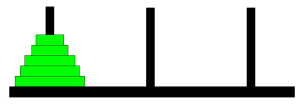by Victor Bryant
Published Friday June 14 2024

The famous “Tower of Hanoi” puzzle consists of a number of different-sized rings in a stack on a pole with no ring above a smaller one. There are two other poles on which they can be stacked and the puzzle is to move one ring at a time to another pole (with no ring ever above a smaller one) and to end up with the entire stack moved to another pole.
Unfortunately I have a faulty version of this puzzle in which two of the rings are of equal size. The minimum number of moves required to complete my puzzle (the two equal rings may end up in either order) consists of four different digits in increasing order.
What is the minimum number of moves required?
